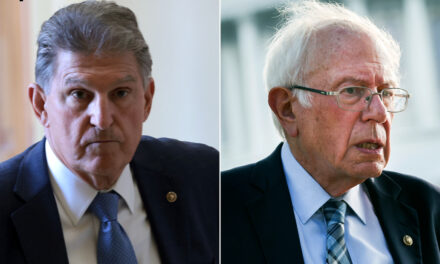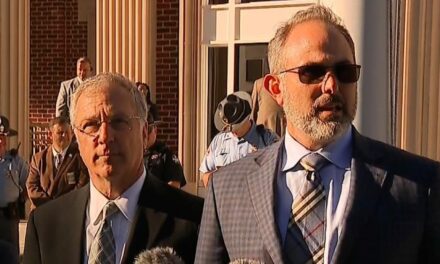
Trump campaign hopes to have it both ways with racial rhetoric
While one voter may see their social media flooded with portrayals of Trump championing criminal justice reform and bringing down Black and Hispanic unemployment, another will find Willie Horton-style ads that use mugshots of Black people to portray Biden as weak on crime.
“We will message to Black men that she was California’s top cop and message to suburban women that she wants to defund the police,” a Trump political adviser said. “Two different demographics, two different messages.”
Fighting to win back disenchanted White suburban voters and save his reelection bid, Trump has mostly abandoned in-person attempts to project a unifying image or engage constructively in the country’s racial reckoning — even as his campaign claims otherwise.
He is amplifying outbreaks of violence surrounding to Black Lives Matter protests; pledging to eliminate funding for federal racial sensitivity trainings and schools that use the “1619 Project” to teach kids about slavery; defending the presence of Confederate symbols in public; warning of an “invasion” of low-income people into the suburbs; and denigrating the first Black woman on a major party ticket by playing on racist and sexist tropes.
While his campaign is amplifying Trump’s “law and order” message and doing just as much to stoke fear about unrest in some American cities, it is also actively engaged in an effort to convince voters — or at least White voters — that Trump can’t be racist because of policies that have benefited minorities.
‘Really, was that necessary?’
With the coordinated pageantry and disciplined messaging of the GOP convention behind them, some advisers are worried Trump’s rhetoric could bury those efforts, undermining a more nuanced official message.
“He’s always going one step too far,” the adviser said of Trump’s racially charged appeals. “And we go, like, ‘Really, was that necessary?’ ”
There are signs Trump’s efforts are failing to move the needle among the suburban voters Trump believes he is attracting using racially divisive language. Trump experienced almost no post-convention bounce, and his rival Joe Biden is enjoying the steadiest polling lead in history.
View Trump and Biden head-to-head polling
Instead of adjusting course, Trump has dug in. He has told advisers that “my people” aren’t looking for a unifying president and has fretted his mostly White conservative supporters are turned off by messaging that even acknowledges underlying concerns about racial injustice or police brutality.
Trump has ignored those topics in favor of advancing a “law and order” mantra he believes is better received among conservatives and railing against any attempt to reckon with the country’s racist history.
In recorded interviews with journalist Bob Woodward for his new book, “Rage,” Trump rejects the idea that he or other White Americans should examine the privileges they are afforded because of their race and try to understand the anger and pain of Black Americans.
“You really drank the Kool-Aid, didn’t you? Just listen to you. Wow,” Trump told Woodward. “No, I don’t feel that at all.”
Trump is also waging a deeply personal assault on Harris, whom Trump has called “nasty,” “disrespectful” and the “meanest,” playing into racist and sexist stereotypes about Black women.
“You know what, people don’t like her. Nobody likes her,” Trump said during a campaign rally in Winston-Salem, North Carolina, on Tuesday. “She could never be the first woman president. She could never be. That would be an insult to our country.”
Issues of race and ethnicity have always been central to Trump’s political persona, from his stoking of a racist conspiracy about President Barack Obama’s birthplace to his description of Mexicans as “rapists” at his 2015 campaign announcement to his more recent dismissals of attempts to confront with the country’s racist past.
Through most of it, Trump has simultaneously attempted to paint himself a champion for minorities, citing primarily his efforts to improve their economic standing and using his personal friendships as evidence he is not himself racist.
“I’ve done a tremendous amount for the Black community,” Trump told Woodward in July. “And, honestly, I’m not feeling any love.”
Having it both ways
While Trump is cranking up race-based appeals and a law-and-order message at the expense of almost any other approach, the Trump campaign is still trying to have it both ways: amplifying Trump policies and minority voices to make the case that Trump isn’t racist, while also stirring fears about unrest in American cities.
In a radio ad airing on urban stations this week, the President relies on testimony from football star Herschel Walker: “I’ve known Donald Trump for 37 years,” Walker says in the ad. “He keeps right on fighting to improve the lives of Black Americans. He works night and day. He never stops. He leaves nothing on the field.”
That was a message at the core of the Republican National Convention last month and campaign advisers cite a momentum swing in the wake of the convention that pushed Biden to more forcefully condemn rioting as evidence that their strategy is working. One Trump adviser also claimed internal polling showed the race tightening in key battleground states.
“A part of regaining suburban White voters is showing them what Donald Trump has done for black and Hispanic communities,” a Trump campaign adviser said. The other part is amplifying the unrest in Democratic cities, the adviser said.
While Trump’s political orbit insists a momentum swing is underway and reflected in internal polling, public polling tells a different story when it comes to the suburban voters Trump needs to win back.
Nationally, Trump’s support among suburban voters has been at a standstill: 35% of suburban voters supported him over Biden in a June New York Times/Sienne poll and that figure held steady in a poll this month from Grinnell College.
And in the swing states of Wisconsin, Arizona and North Carolina, Trump faces eight-, seven- and nine-point deficits, respectively, with suburban voters against Biden, according to Fox News polls.
Trump’s “law and order” messaging may also be missing the mark. Voters consistently rank the coronavirus pandemic and the economy as their top concerns while crime often lags far behind, according to several polls.
Cultural battles
Trump, however, remains convinced that his supporters do prioritize the cultural battles he continues to stoke, even if polling doesn’t bear that out. It was the President who identified racial sensitivity training as an area he could take action, people familiar with the matter said, after seeing a segment on Tucker Carlson’s Fox News program on Tuesday that featured Christopher Rufo, a conservative filmmaker and scholar.
“What I’ve discovered is that critical race theory has become in essence the default ideology of the federal bureaucracy and is now being weaponized against the American people,” Rufo said on the program.
Afterward, Trump told aides to halt funding for training programs that he claimed were instilling anti-American views in federal employees, suggesting they were the work of the “deep state” intent on undermining his presidency. Work began on drafting the memo that Trump’s budget director ultimately sent to the heads of federal agencies on Friday afternoon.
Initially, the memo was not heavily publicized. But on Saturday, Trump began promoting the move on Twitter, retweeting accounts thanking him for taking the step and asking followers to help identify where the trainings were taking place.
“Please report any sightings so we can quickly extinguish!” he wrote.
One official said some classes had already been canceled because of the memo, though it wasn’t clear the extent of the document’s effect. In it, the Office and Management and Budget said more guidance would be forthcoming.
The move came after Trump’s visit to Kenosha, Wisconsin, and seemed to codify into federal policy the dismissive view he took there when asked about systemic racism.
“You know you just keep getting back to the opposite subject. We should talk about the kind of violence we’ve seen in Portland and here and other places,” Trump said.
It also came as his onetime personal attorney Michael Cohen was revealing in a new book the extent of Trump’s animus toward his predecessor, which Cohen claims was rooted in racism. Cohen said before Obama was elected, Trump privately described him as “a Manchurian candidate” who obtained his Ivy League degrees only by way of affirmative action.
Trump’s disdain for Obama was so extreme that he took his fixation a step further, according to Cohen: Trump hired a “Faux-Bama” to participate in a video in which Trump “ritualistically belittled the first black president and then fired him.”
More recently, Trump has used an Obama-era housing rule as a way to instill unease among suburban voters using racially fraught issues. He wrote on Twitter that Biden “has pledged to ABOLISH Suburban Communites as they currently exist,” citing the rule that was meant to combat segregation.
Trump has used the issue frequently to suggest that more low-income housing in suburbs would ruin communities, and has claimed Sen. Cory Booker of New Jersey, a Black man, would lead the charge.
“There goes Suburbia!” he wrote on Tuesday.

















